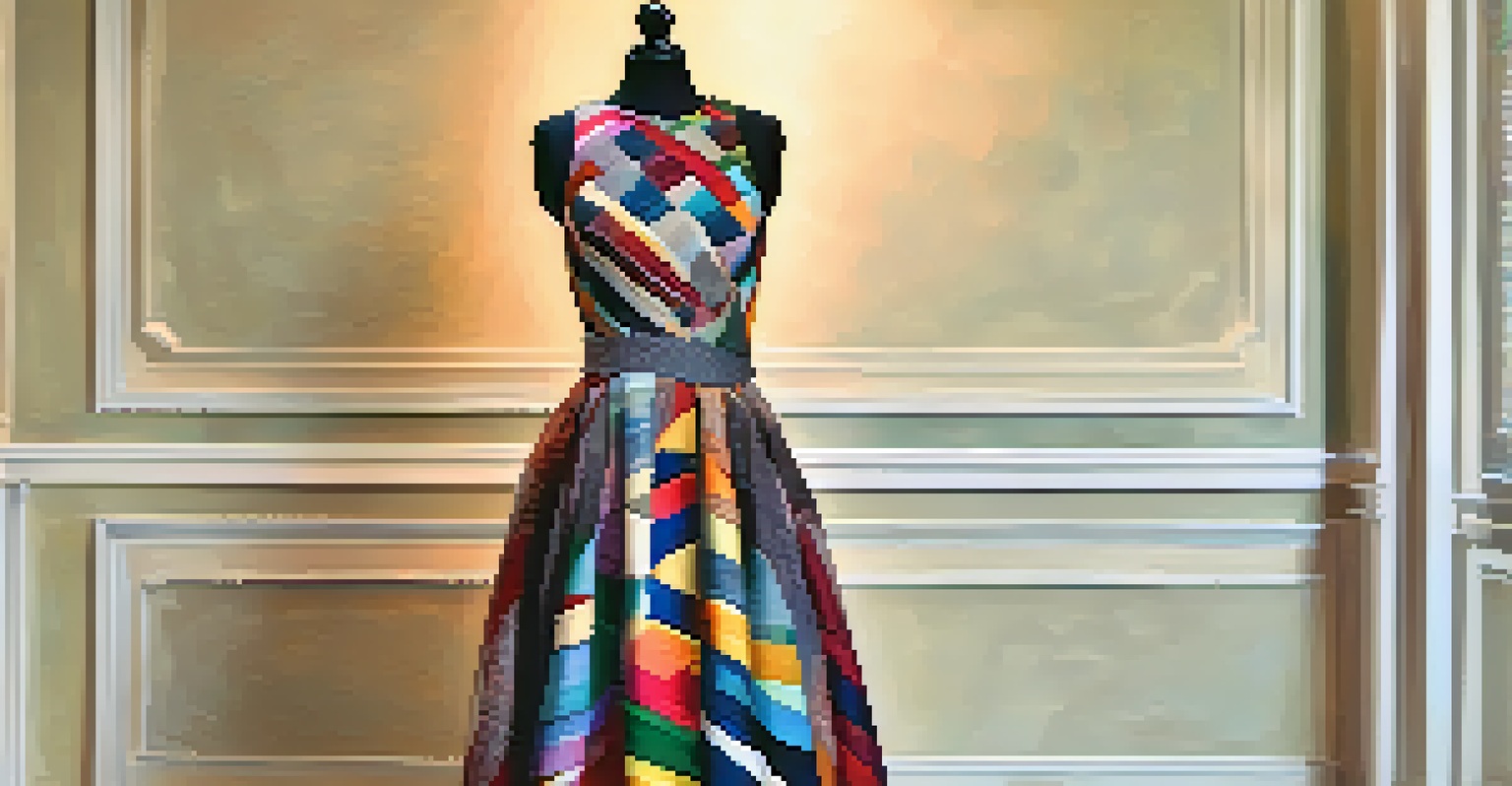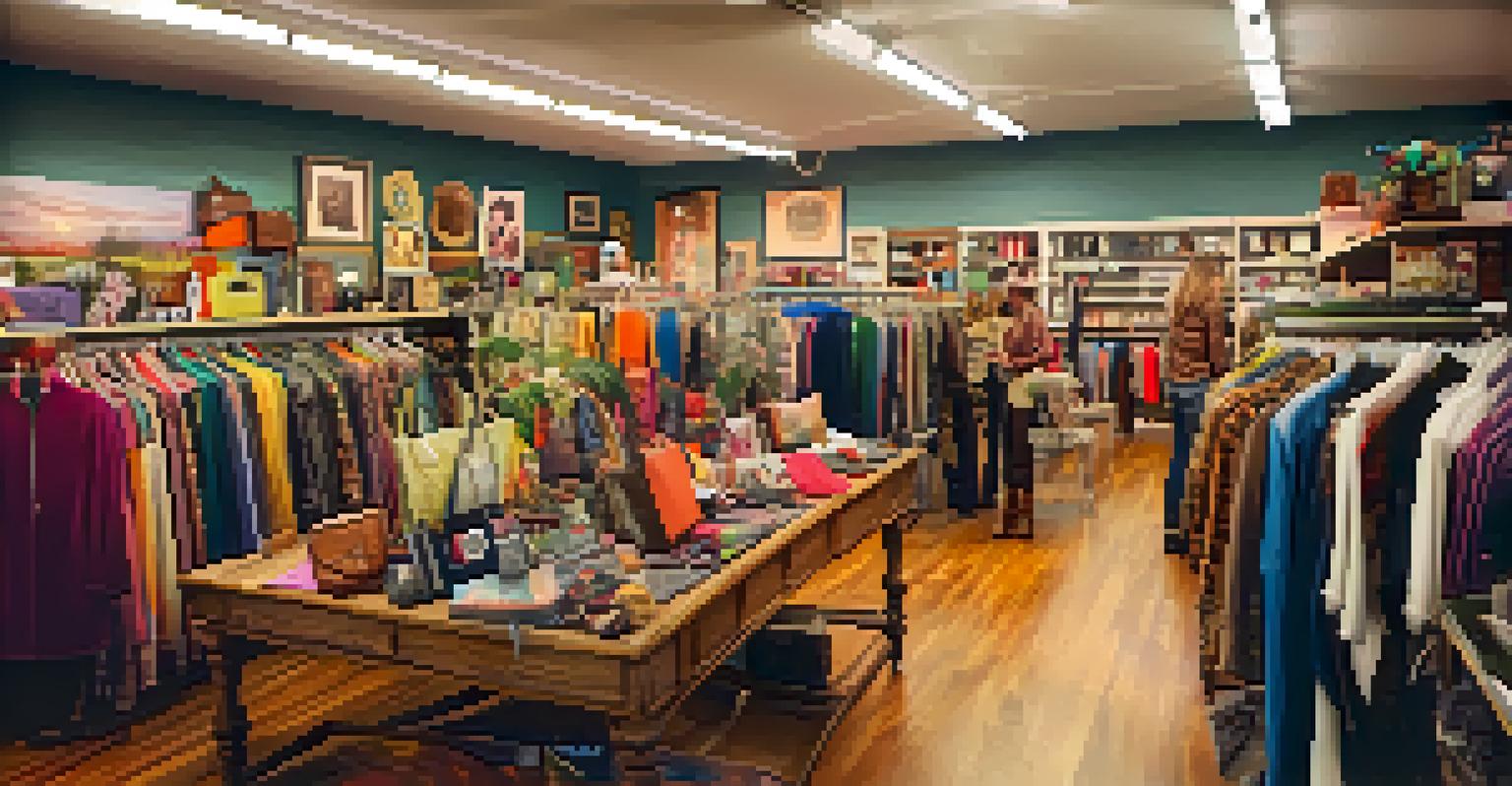The Rise of Upcycled Luxury: Transforming Waste into Fashion

Understanding Upcycling: More Than Just Recycling
Upcycling is the creative process of transforming waste materials into new products, particularly in fashion. Unlike recycling, which often breaks down materials to their basic components, upcycling retains the original integrity of the items while giving them a new life. For example, old denim jeans can be transformed into stylish bags, showcasing the potential of what might otherwise be discarded.
One person's trash is another person's treasure.
This process not only minimizes waste but also promotes sustainability in the industry. As consumers become more environmentally conscious, the demand for upcycled products has surged, leading designers to explore innovative ways to incorporate waste into their collections. Imagine a chic dress made from repurposed fabric scraps—it's not only fashionable but also eco-friendly.
Ultimately, upcycling invites creativity into the fashion world. By viewing waste as a resource, designers can push the boundaries of traditional fashion, creating unique pieces that tell a story. This shift is redefining luxury, moving away from the exclusivity of brand new materials and towards a more sustainable mindset.
The Environmental Impact of Fashion Waste
The fashion industry is notorious for its environmental footprint, generating a staggering amount of waste each year. With millions of tons of clothing ending up in landfills, the urgency to find sustainable solutions has never been greater. Upcycling offers a powerful alternative, drastically reducing the waste produced while still delivering high-quality, luxurious items.

By transforming discarded materials into fashionable pieces, upcycled luxury helps mitigate pollution and resource depletion. For instance, the process of making new clothes often requires vast amounts of water and energy, but upcycling can significantly cut down on these needs. This shift not only benefits the planet but also encourages a more responsible consumer culture.
Upcycling Redefines Fashion Waste
Upcycling transforms discarded materials into stylish products, minimizing waste while promoting sustainability in the fashion industry.
Furthermore, the use of upcycled materials can spark conversations around sustainability and ethical fashion. As brands embrace this practice, they highlight the environmental issues tied to fast fashion, urging consumers to rethink their purchasing habits. This dialogue is crucial for fostering a more sustainable fashion future.
Designers Leading the Upcycled Luxury Movement
Numerous designers and brands are at the forefront of the upcycled luxury trend, creatively reimagining waste into runway-ready pieces. Labels like Stella McCartney and Reformation have pioneered this movement, proving that sustainability and style can coexist. Their collections often feature items made from reclaimed materials, showcasing the beauty in what was once considered trash.
Sustainability is no longer about doing less harm. It's about doing more good.
These designers often share their stories and processes, inviting consumers into their world of creativity and sustainability. For instance, some brands host workshops where customers can learn about upcycling techniques or even participate in the creation of new items. This hands-on approach not only fosters a deeper appreciation for the craft but also cultivates a community around sustainable fashion.
Moreover, these designers are inspiring a new generation of creatives to embrace the upcycling ethos. As more emerging talents enter the fashion industry with a focus on sustainability, the possibilities for innovative design continue to expand. The future of fashion lies in this collaborative spirit, where luxury and environmental consciousness go hand in hand.
The Role of Consumers in Upcycling Luxury Fashion
Consumers play a vital role in the rise of upcycled luxury, as their choices directly impact the fashion industry's direction. With a growing awareness of environmental issues, many shoppers are actively seeking sustainable options, prompting brands to respond accordingly. This shift in consumer behavior has led to a surge in demand for upcycled products, thereby driving innovation in the market.
Additionally, consumers are increasingly valuing the stories behind their purchases. When someone buys an upcycled item, they are not just acquiring a product; they are investing in a narrative of sustainability and creativity. This connection enhances the emotional value of the purchase, making it more meaningful and unique.
Consumer Choices Drive Sustainability
As consumers increasingly seek sustainable options, their choices significantly influence brands to adopt upcycling practices.
As shoppers embrace this mindset, they also help promote a culture of sustainability within the fashion industry. By supporting brands that prioritize upcycling and innovation, consumers send a strong message that eco-friendly practices are essential. This collective effort can lead to lasting change, encouraging more brands to adopt sustainable methods in their production processes.
Challenges Facing Upcycled Luxury Fashion
While upcycled luxury fashion is on the rise, it isn't without its challenges. One significant hurdle is the perception of upcycled products as being of lower quality or less desirable than new items. Overcoming this stereotype requires consistent efforts from designers to showcase the craftsmanship and uniqueness of upcycled products. As consumers become more aware of the artistry involved, this perception can shift.
Additionally, sourcing high-quality materials for upcycling can be difficult. Designers must navigate the complexities of finding suitable waste materials that align with their vision. This can lead to increased production time and costs, which may deter some brands from fully committing to upcycling practices.
Despite these challenges, the upcycled luxury movement continues to grow. With increasing consumer demand and a commitment to sustainability, designers are finding innovative ways to overcome obstacles. As this trend evolves, it has the potential to reshape the fashion landscape into one that values creativity, quality, and environmental responsibility.
The Future of Upcycled Luxury in Fashion
The future of upcycled luxury looks promising as more brands and designers embrace sustainable practices. As the conversation around climate change and environmental issues continues to gain momentum, the upcycling movement is likely to expand. With advancements in technology and materials, the possibilities for innovative upcycled fashion are endless, paving the way for creative solutions to traditional fashion challenges.
In addition, as consumers become increasingly aware of the impact of their choices, they will continue to support brands that prioritize sustainability. This shift in consumer behavior will encourage more designers to incorporate upcycled materials into their collections, further solidifying its place in the fashion industry. Imagine a world where every piece of clothing tells a story of transformation and creativity.
Challenges in Upcycled Luxury
Despite its growth, upcycled luxury fashion faces challenges such as perceptions of lower quality and sourcing high-quality materials.
Ultimately, upcycled luxury fashion is not just a trend; it represents a significant cultural shift towards sustainability. As the industry evolves, it will be exciting to see how designers continue to push the boundaries of creativity while remaining committed to the environment. The journey towards a more sustainable fashion future is just beginning.
How to Embrace Upcycled Luxury in Your Wardrobe
Embracing upcycled luxury in your wardrobe is easier than you might think. Start by exploring brands that prioritize sustainable practices and offer unique upcycled pieces. By choosing to support these brands, you contribute to a more sustainable fashion industry while enjoying one-of-a-kind items that stand out from the crowd.
Another way to incorporate upcycled luxury into your wardrobe is to explore thrift stores and vintage shops. These places often have hidden gems waiting to be discovered. You can find high-quality items that can be upcycled or reimagined into something fresh and exciting, allowing you to express your personal style creatively.

Lastly, consider participating in upcycling workshops or DIY projects. Not only can you learn new skills, but you can also create custom pieces that reflect your style and values. Whether it's turning an old shirt into a tote bag or repurposing fabric scraps into accessories, embracing upcycled luxury allows you to contribute to sustainability while having fun.